WFV Tuesday 10th December Christmas Meeting
Margaret
Margaret
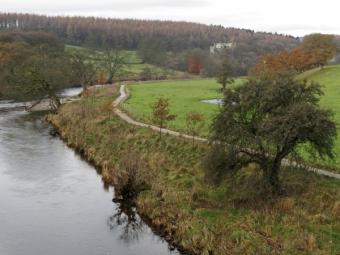 View From The AqueductThe mystery trip is now becoming an annual tradition which is proving to be popular. Unfortunately Joan had withdrawn from the trip but about 20 people attended this outing to Strid Woods. The group divided into 2; the ramblers led by Donald walked as far as Barden Bridge and John's amblers who went only as far as the aqueduct. The amblers spent much of the route looking at fungi including wrinkled club, lumpy bracket and olive oysterling. Bird sightings included mandarin ducks and a dipper but the highlight was seeing 3 goldcrest one of which had an unusually broad yellow band on his head.
View From The AqueductThe mystery trip is now becoming an annual tradition which is proving to be popular. Unfortunately Joan had withdrawn from the trip but about 20 people attended this outing to Strid Woods. The group divided into 2; the ramblers led by Donald walked as far as Barden Bridge and John's amblers who went only as far as the aqueduct. The amblers spent much of the route looking at fungi including wrinkled club, lumpy bracket and olive oysterling. Bird sightings included mandarin ducks and a dipper but the highlight was seeing 3 goldcrest one of which had an unusually broad yellow band on his head.  Panellus serotinus (Olive oysterling)The ramblers were the first to arrive for lunch by the aqueduct. After lunch, some chose to go back via the same route whilst others followed the path on the other side of the river. A pause in the "bird hut" gave an opportunity to see coal tits and nuthatches feeding on scattered seed. A botanical highlight was the beech fern, one of 9 ferns noted. Many of the group rounded off the day with a visit to the Cavendish Pavilion tea shop for refreshments. A lovely, crisp sunny day out.
Panellus serotinus (Olive oysterling)The ramblers were the first to arrive for lunch by the aqueduct. After lunch, some chose to go back via the same route whilst others followed the path on the other side of the river. A pause in the "bird hut" gave an opportunity to see coal tits and nuthatches feeding on scattered seed. A botanical highlight was the beech fern, one of 9 ferns noted. Many of the group rounded off the day with a visit to the Cavendish Pavilion tea shop for refreshments. A lovely, crisp sunny day out. Sue
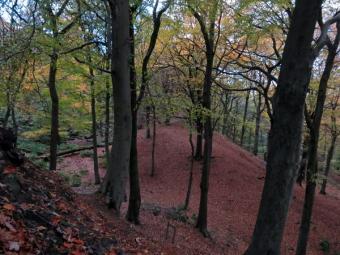 AutumnThe walk was led by Brian Ellis and Amanda Smith. The old mini-bus was used for a change and the driver was Robert who is back with the group after a few years away. He has an eagle eye when it comes to spotting small fungi! As with nearly all our fieldtrips of late the weather was a delight.
AutumnThe walk was led by Brian Ellis and Amanda Smith. The old mini-bus was used for a change and the driver was Robert who is back with the group after a few years away. He has an eagle eye when it comes to spotting small fungi! As with nearly all our fieldtrips of late the weather was a delight.Lots of blue sky, not too cold and not too windy. We meandered along the Oak trail, mainly looking at fungi. When I say meandered, it wasn't as fast as that! The group kept finding fungi for Joan and myself to ID. Eventually we had to say enough 'no more finding fungi' otherwise we would not have travelled more than 200 yards.
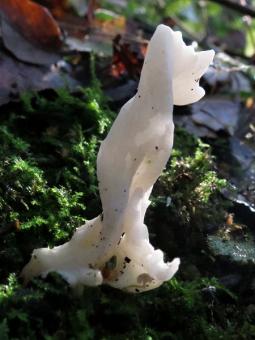 Wrinkled ClubThe steep woodland offered up some splendid views of the valley below. Birdlife was almost totally absent. Joan and Alice managed to find 4 species of fern and 5 flowering plants. Lunch was taken on top of a rocky hillside overlooking a stand of beeches far below. None of the group ventured to the bottom apart from Sir Galahad (Alan to his friends) who gallantly rescued the cup that Amanda had accidently? dropped. He gasped his way back to the top, then had to lie down!
Wrinkled ClubThe steep woodland offered up some splendid views of the valley below. Birdlife was almost totally absent. Joan and Alice managed to find 4 species of fern and 5 flowering plants. Lunch was taken on top of a rocky hillside overlooking a stand of beeches far below. None of the group ventured to the bottom apart from Sir Galahad (Alan to his friends) who gallantly rescued the cup that Amanda had accidently? dropped. He gasped his way back to the top, then had to lie down!
The fungi found were mainly brackets and crusts;  Sulphur TuftBirch Bracket/Polypore, Blushing Bracket, Turkeytail, Lumpy Bracket, Variable and Peeling Oysterlings and Coral Spot. Other fungi were: Candlesnuff, Sulphur Tuft, Common Earthballs, Crampballs aka King Arthur's Cakes, Milking Bonnet, Pleated Parasoll, Sheathed Woodtuft/Two toned Woodtuft, Wrinkled Club and an overgone Orange Birch Bolete. We didn't find any Russulas or Lactarias or other Boletes, possibly because it is now getting late in the fungi season.
Sulphur TuftBirch Bracket/Polypore, Blushing Bracket, Turkeytail, Lumpy Bracket, Variable and Peeling Oysterlings and Coral Spot. Other fungi were: Candlesnuff, Sulphur Tuft, Common Earthballs, Crampballs aka King Arthur's Cakes, Milking Bonnet, Pleated Parasoll, Sheathed Woodtuft/Two toned Woodtuft, Wrinkled Club and an overgone Orange Birch Bolete. We didn't find any Russulas or Lactarias or other Boletes, possibly because it is now getting late in the fungi season.
We were accompanied by a student called Betony, who currently works in Mytholmroyd with Hugh Firman. She had various species list that she updated as we went round. The day ended with a pitstop at the Willow Tree Cafe in a nearby garden centre.
John Gavaghan
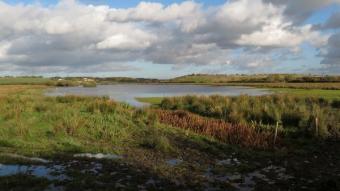 View From Lin Dike HideThe group numbering 13 was capably led for the day by Stuart who also did the driving. This was his final outing of the year before departing for the sunshine of South Africa. The original plan had been to visit Wheldrake Ings Nature reserve, however the conditions there were dry with little birding interest. Fairburn Ings proved to be an excellent choice for birds, berries, fungi and all else. The weather conditions were variable - sometimes breezy but sunny with good visibility and no rain.
View From Lin Dike HideThe group numbering 13 was capably led for the day by Stuart who also did the driving. This was his final outing of the year before departing for the sunshine of South Africa. The original plan had been to visit Wheldrake Ings Nature reserve, however the conditions there were dry with little birding interest. Fairburn Ings proved to be an excellent choice for birds, berries, fungi and all else. The weather conditions were variable - sometimes breezy but sunny with good visibility and no rain. 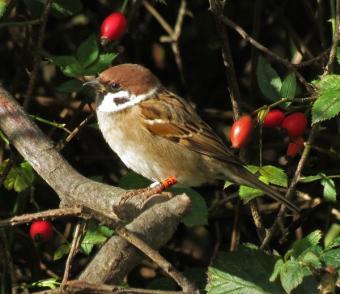 Tree SparrowThe ducks seemed to be enjoying the conditions on the main lake - Coot, Wigeon, Teal, Tufted ducks and Gadwall were seen in good numbers as well as Mute swans, Greylag and Canada geese. Willow Tit and Kingfisher were seen from the viewing screens. Goldfinch, Tree sparrow, Greenfinch were using the feeders, while Siskin and Redwing were viewed in the trees. A total of 38 bird species were seen on the day, a good haul.
Following lunch the party divided into two groups, five stayed in the vicinity of the visitors centre while seven "The Magnificent Seven" named by John departed in the minibus for Lin Dike. The highlight species for the day was seen through the scope resting in the sunshine on a branch of a pylon - a Peregrine.
Tree SparrowThe ducks seemed to be enjoying the conditions on the main lake - Coot, Wigeon, Teal, Tufted ducks and Gadwall were seen in good numbers as well as Mute swans, Greylag and Canada geese. Willow Tit and Kingfisher were seen from the viewing screens. Goldfinch, Tree sparrow, Greenfinch were using the feeders, while Siskin and Redwing were viewed in the trees. A total of 38 bird species were seen on the day, a good haul.
Following lunch the party divided into two groups, five stayed in the vicinity of the visitors centre while seven "The Magnificent Seven" named by John departed in the minibus for Lin Dike. The highlight species for the day was seen through the scope resting in the sunshine on a branch of a pylon - a Peregrine.
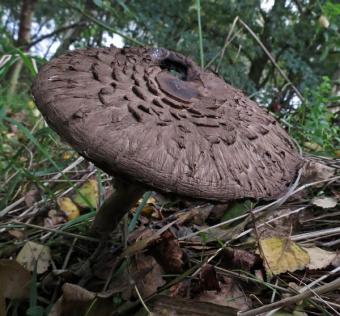 Shaggy Parasol
Shaggy Parasol
Other species spotted were Cormorant, Shoveler, Shelduck and Curlew. Notable botanical species (some plants were still in flower) were Hop and Button weed, an alien plant also seen at Waters Edge country park.The fungi group were equally delighted with their finds of the day including a family of Earth Balls, Brown Rollrim, Wood Blewitt, Peeling oysterling, Shaggy Parasol, Brown Birch Bolete, Small Stagshorn to name a few. Several Brown Hawker dragonflies were seen along the path. The finale for the day was a slice of Margaret's apple and ginger cake made from a recipe provided by Julia using apples from the Community orchard. Thanks to Stuart and others for giving us a highly enjoyable autumnal day out.
Margaret
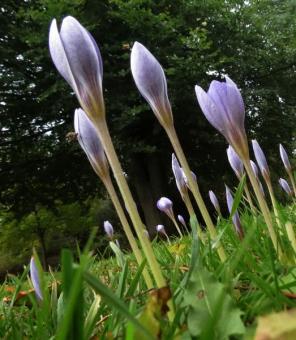 Autumn CrocusesThe attendance on today’s trip was reduced by illness to three of our regular members and we hope that Martin, Alice and today’s intended joint leader, John, are soon recovered. The wet weather of the last few days relented again for our Tuesday outing which got off to a bright start when our intrepid driver Sue used her charm to gain free entrance for the group to the grounds of Lotherton Hall for our annual fungus foray.
Joan took on the leadership for the day, assisted by Veronica, and as she led us from the car park to the woods we were reminded that autumn is upon us when a flock of redwings flew over. Further evidence of autumn was all around with leaves beginning to turn and fruits and nuts abundant in the hedgerows whilst the stags in the deer park were looking decidedly frisky.
Autumn CrocusesThe attendance on today’s trip was reduced by illness to three of our regular members and we hope that Martin, Alice and today’s intended joint leader, John, are soon recovered. The wet weather of the last few days relented again for our Tuesday outing which got off to a bright start when our intrepid driver Sue used her charm to gain free entrance for the group to the grounds of Lotherton Hall for our annual fungus foray.
Joan took on the leadership for the day, assisted by Veronica, and as she led us from the car park to the woods we were reminded that autumn is upon us when a flock of redwings flew over. Further evidence of autumn was all around with leaves beginning to turn and fruits and nuts abundant in the hedgerows whilst the stags in the deer park were looking decidedly frisky. Dog Stinkhorn
Dog Stinkhorn
Our foray progressed at the usual BEES pace as we discovered a wide variety of fungi in the woods, including the highlight of the day, the uncommon Dog Stinkhorn, spotted by Sue’s eagle eyes. We returned to the stable courtyard for lunch and were able to take shelter there when a very brief shower passed over. After lunch the group split up to explore the various different attractions of the site; 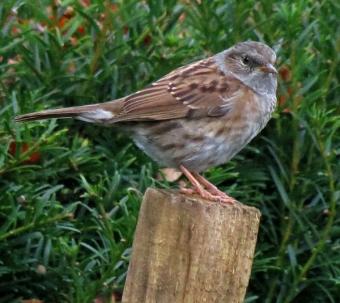 Dunnocksome visiting the house, others the bird garden, the formal garden and the orchard which provided rich pickings amongst the windfalls
Dunnocksome visiting the house, others the bird garden, the formal garden and the orchard which provided rich pickings amongst the windfalls
The wild bird count was low but we were delighted to see a few ladybirds and even one or two butterflies – a comma and an unidentified species, probably a peacock. A return to the café was on the agenda for many of the group before we departed on our uneventful journey back to Bradford, early enough to avoid any traffic hold ups. A very pleasant day at a rewarding destination; thanks to Joan for her expertise and to Sue for her driving and photography skills.
Stuart
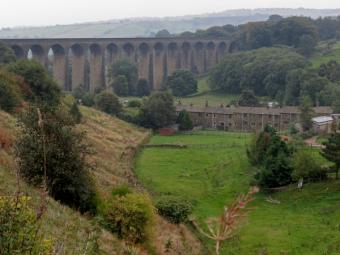 Thornton Viaduct
Thornton ViaductToday's trip was very local but proved to be a popular one with 19 participants. The Great Northern Trail is a work in progress and our walk this week was along a newly opened section which runs from Thornton to Queensbury. ( We didn't plan to walk all the way to Queensbury!!). This year's summer has been lovely and has extended right through to the end of September but it had firmly closed its doors for the season and the strong wind really added a chill to the drop in temperature. From our meeting point at South Square we headed for the trail which turns off Thornton Road close to Thornton Primary. Before taking the trail across the viaduct we explored a wooded path which branches off the trail. It was here that we found quite a lot of fungi.  White KnightAs well as a number of fly agaric there was an assemblage of white fungi, some quite large, later identified as White Knight, Tricholoma album. Other fungi seen were Sheathed Woodtuft, Blushing Bracket, Honey Fungus and Puffballs. There was some uncertainty about whether some were Earthballs or Puffballs.
White KnightAs well as a number of fly agaric there was an assemblage of white fungi, some quite large, later identified as White Knight, Tricholoma album. Other fungi seen were Sheathed Woodtuft, Blushing Bracket, Honey Fungus and Puffballs. There was some uncertainty about whether some were Earthballs or Puffballs.
After exploring this path we headed back and crossed the Thornton Viaduct. The route is quite exposed and the cold was starting to bite. The more eagle-eyed folk in our group (Sally and John) spotted a sign for hot drinks at a local farm and took full advantage of this welcome offer. The devout botanists on the other hand really took their time and enjoyed identifying the plants many of which were flowering later than usual. 119 plants and ferns were recorded including Musk Mallow, Marsh meadow Grass, Spotted Medick, Swinecress and Common Mallow. Few birds were seen today. A jay was spotted and we did see some crows and thrushes having a tussle over prime tree territory.
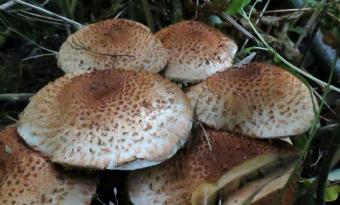 Honey FungusThe original plan for the day had been to try and walk as far as Station Road but after eating our packed lunches we continued only as far as Cockin Lane before we decided to head back to Thornton. This week is National Older People's Week and South Square was holding an afternoon tea and reminiscence event. We were glad to get warm and enjoy the generous hospitality - as soon as a teapot was emptied it was filled again and cakes were also on offer. A small donation of £1 was requested. The Thornton Antiquarian Society had created a table display of artefacts and this did generate some reminiscing from our group.
Honey FungusThe original plan for the day had been to try and walk as far as Station Road but after eating our packed lunches we continued only as far as Cockin Lane before we decided to head back to Thornton. This week is National Older People's Week and South Square was holding an afternoon tea and reminiscence event. We were glad to get warm and enjoy the generous hospitality - as soon as a teapot was emptied it was filled again and cakes were also on offer. A small donation of £1 was requested. The Thornton Antiquarian Society had created a table display of artefacts and this did generate some reminiscing from our group.
Although cold it was an enjoyable day out and it is always good to explore the local area. Thanks to Lorna and Joan, our leaders for today.
Sue
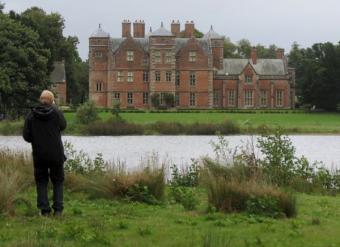 Kiplin HallThere were several aspects to this autumn visit to Kiplin Hall - an historical house with treasures and war time connections: a delightful walled garden with woodland and parkland beyond: a large Lake: plants and trees bearing seeds, berries and fruit as well as late flowers: some fungal delights: a story telling session and finally a birthday celebration!
We arrived at our destination earlier than anticipated and decided to do a one mile walk (some would refer to it as a stroll ) around the large Lake, a former site of gravel extraction. The sky was overcast, the rain kept at bay but oh it was decidedly chilly. Good views of the Hall and Folly were had from the Lake. Greylag and Canada Geese were seen on the Lake as well as Tufted Duck and Great Crested Grebe.
Kiplin HallThere were several aspects to this autumn visit to Kiplin Hall - an historical house with treasures and war time connections: a delightful walled garden with woodland and parkland beyond: a large Lake: plants and trees bearing seeds, berries and fruit as well as late flowers: some fungal delights: a story telling session and finally a birthday celebration!
We arrived at our destination earlier than anticipated and decided to do a one mile walk (some would refer to it as a stroll ) around the large Lake, a former site of gravel extraction. The sky was overcast, the rain kept at bay but oh it was decidedly chilly. Good views of the Hall and Folly were had from the Lake. Greylag and Canada Geese were seen on the Lake as well as Tufted Duck and Great Crested Grebe.  Fringed Water LilyAn interesting variety of shrubs and water loving plants were seen mainly in seed. The Loosestrife which would have looked very attractive earlier in the month had now gone over. However the Water lilies White and Fringed were in flower. Other noteworthy flowers and shrubs were Dovesfoot Cranesbill, Centaury, Red Bartsia as well as Dog Wood with its white flowers and berries. Three Waxcap specimens were found in a grassy area.
At lunch time the group divided into "the softies" who went in search of sustenance in the cafe. They were successful! The "story telling group" enjoyed listening to Joan's tale of "Jack and the Beanstalk" while sitting on low benches in the children's play area. We toured the Walled Garden before assembling for an exploration of the Hall with its history, Maryland connection, paintings and porcelain.
Fringed Water LilyAn interesting variety of shrubs and water loving plants were seen mainly in seed. The Loosestrife which would have looked very attractive earlier in the month had now gone over. However the Water lilies White and Fringed were in flower. Other noteworthy flowers and shrubs were Dovesfoot Cranesbill, Centaury, Red Bartsia as well as Dog Wood with its white flowers and berries. Three Waxcap specimens were found in a grassy area.
At lunch time the group divided into "the softies" who went in search of sustenance in the cafe. They were successful! The "story telling group" enjoyed listening to Joan's tale of "Jack and the Beanstalk" while sitting on low benches in the children's play area. We toured the Walled Garden before assembling for an exploration of the Hall with its history, Maryland connection, paintings and porcelain. 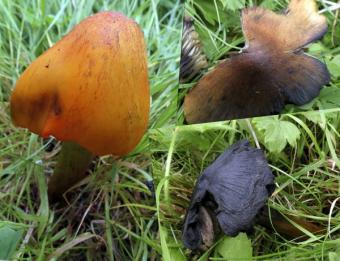 Blackening Waxcap Stages
Blackening Waxcap Stages
We had anticipated meeting Andrew and Lorna however they were nowhere to be seen. In the late afternoon the party, some of whom had explored the gardens and grounds, gravitated to the excellent tea room. The minbus left around 4pm. En route some mini Welsh cakes were distributed in celebration of Margaret's birthday . As if people hadn't eaten enough during the day! We arrived back around 5 30pm having enjoyed good driving conditions. It had been a varied, relaxing and good day out. Thanks to Brian, Sue and Margaret.
Margaret
It was a treat for me to be out with the group today, and to be in the company of so many members was a pleasure. There were twenty two of us at Denso Marston for the first stop of this tour of Baildon sites.
The Denso Marston Reserve was created 25 years ago as a condition of the company building on the river corridor. They now employ a warden 3 days a week to manage the reserve and co-ordinate the education visits. Today we were led around by volunteer Harry Whiteley. His knowledge of the reserve and of insects in particular greatly enhanced our visit. Harry told us of two species of hoverfly whose larvae eat rotting wood. They have recently been identified at Denso - the first recordings in this area.
 Southern HawkerThe weather was very kind with some end of summer sunshine encouraging the dragonflies around the pond. We saw a Southern Hawker laying eggs on the plants at the margin of the pond while the male patrolled nearby, and several Brown Hawker feeding over the water.
Southern HawkerThe weather was very kind with some end of summer sunshine encouraging the dragonflies around the pond. We saw a Southern Hawker laying eggs on the plants at the margin of the pond while the male patrolled nearby, and several Brown Hawker feeding over the water.
The Purple Loosestrife was in full flower, and in total 107 species of flower were recorded either in flower or fruit, including Musk Mallow, Lesser Bullrush and Fringed Water Lily.
After lunch and group photos, we relocated to nearby Tong Park. The plants here included Greater Birds-foot Trefoil, Burr Reed and Water Pepper. John informed us the grassy bank with a good amount of Devil's Bit Scabious was one of the best places in Baildon for Small Copper butterflies and Wall Browns, however none had been seen this year. Several people were lucky to see the flash of a kingfisher across the large pond by the cricket ground, were there was also several Little Grebe, Moorhens and Swans.
The final stop of the day, via the ice cream van, was to the area of Baildon Moor where BEES Conservation Volunteers have undertaken bracken control for the last decade. I explained the principles of the work undertaken and we had a quick look at the moorland plants that are benefiting from management; Heather, Cross-Leaved Heath, Bilberry (still in flower) and Crowberry. With the Meadow Pipits singing we returned to the minibus and back to town.
See the rest of the photos in the gallery . Thanks for having me, Julia.
 Marsh Gentian
Marsh GentianAnother fine weather day for an outing to this extensive YWT nature reserve north of York. Largely cloudy punctuated with periods of sunshine and a pleasant breeze. Warm enough for butterflies to be on the wing throughout the day.
Unusually, there was no toilet stop en route. There are also no facilities on the commons though fortunately sufficient discreet areas!
After parking the bus at the 'Common Road Crossing' car park, north of Strensall, we were led around the section to the west of the railway line by Mike Knaggs, a member of the Botany Group. The main objective was to see a nationally rare plant the Marsh Gentian and this was achieved within the first half hour by Donald who was typically scouting off the main path. Several of these lovely blue flowers, superficially similar to Harebells were found in this one patch. 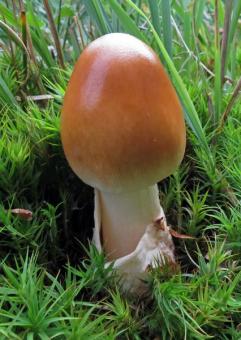 Tawny Grisette (Amanita fulva)All told some 150 flowering plants were counted by Joan, Alice and Eric including Saw-wort.
Tawny Grisette (Amanita fulva)All told some 150 flowering plants were counted by Joan, Alice and Eric including Saw-wort.
Lepidopteran interest was constant with 10 different butterfly species and several day flying moths. Particular mention must be made of Silver Y's which were literally everywhere and must have been in their thousands; species seen: Small Copper, Small Tortoiseshell, Peacock, Small and Green-veined Whites, Meadow Brown, Gatekeeper, Speckled Woods and singleton Small Skipper and Brimstone. Moths; Straw Dot, Shaded-broad Bar, Udea lutealis, Agriphila tristella and the rather splendid Chevron which was a new one for me. 'Hawkeye' Amanda spotted a beautiful Broom Moth caterpillar.
Hardly any birds were seen which is not untypical for August. Many different fungi were seen but except for Penny Bun and Suede Bolete most could only be identified in the field to the following families; Russula, Lactaria, Coprinus and Boletes. A frequently seen bright yellow russula was most probably Russula claroflava.
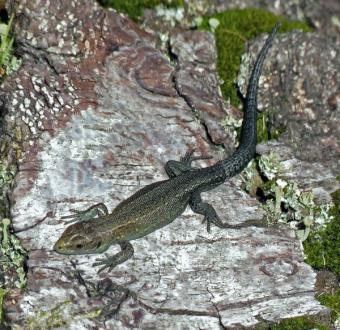 LizardLunch was taken in a patch of long grass alongside a path as there was an absence of logs or stones to sit on. We were however treated to the sight of the Scarboro express steam loco whilst we picnicked.
LizardLunch was taken in a patch of long grass alongside a path as there was an absence of logs or stones to sit on. We were however treated to the sight of the Scarboro express steam loco whilst we picnicked.
Towards the end of the walk Common Lizards were photographed basking on some fallen logs.
Stuart, who took over from Sue for the return leg, had the unenviable task of navigating the vast Clifton Moor Centre in order to find toilets. Another lovely day out and thanks to Mike Knaggs, the drivers and the organisers.
John Gavaghan
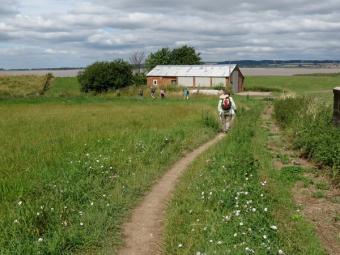 The South Humberside Heritage TrailTwo areas could not have been more different. Last week we were ambling around the limestone grassland and woodland of Brockadale. This week we were walking on the South Humberside Heritage Trail, a linear footpath following the banks of the mighty Humber Estuary and in sight of its magnificent bridge. We made good time on the motorway and met up with new friends Angela and Stuart in the Ness Farm car park of the Far Ings National Nature Reserve.They are both enthusiastic amateur botanists living in the area who met Alice and Margaret on their recent recce. They were helpful and informative companions.
The South Humberside Heritage TrailTwo areas could not have been more different. Last week we were ambling around the limestone grassland and woodland of Brockadale. This week we were walking on the South Humberside Heritage Trail, a linear footpath following the banks of the mighty Humber Estuary and in sight of its magnificent bridge. We made good time on the motorway and met up with new friends Angela and Stuart in the Ness Farm car park of the Far Ings National Nature Reserve.They are both enthusiastic amateur botanists living in the area who met Alice and Margaret on their recent recce. They were helpful and informative companions. 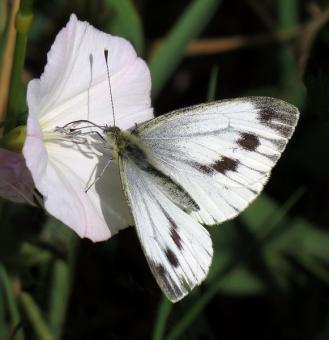 Small White We set off from Ness Farm at our usual slow pace. Angela pointed to a stream that had been alive with water voles in past years. The party was greeted by an overwhelming number and range of butterflies, the count was 10 (how reassuring as they are regarded as an indicator of the health of the environment). They were enjoying the nectar of the plants. Peacocks seemed to have a penchant for Teasel whereas the Small Whites, Gatekeepers, Comma and Peacock were seen dancing around a large patch of Marsh Thistle. Brown Hawker Dragonflies and Blue Tailed Damselflies were seen on the ponds and paths. John reported that he had seen 6 moths including Yellow Shell, Shaded Broad Bar, Silver Y, Udea lutealis, Dingy Footman and Nettle Tap.
Small White We set off from Ness Farm at our usual slow pace. Angela pointed to a stream that had been alive with water voles in past years. The party was greeted by an overwhelming number and range of butterflies, the count was 10 (how reassuring as they are regarded as an indicator of the health of the environment). They were enjoying the nectar of the plants. Peacocks seemed to have a penchant for Teasel whereas the Small Whites, Gatekeepers, Comma and Peacock were seen dancing around a large patch of Marsh Thistle. Brown Hawker Dragonflies and Blue Tailed Damselflies were seen on the ponds and paths. John reported that he had seen 6 moths including Yellow Shell, Shaded Broad Bar, Silver Y, Udea lutealis, Dingy Footman and Nettle Tap. 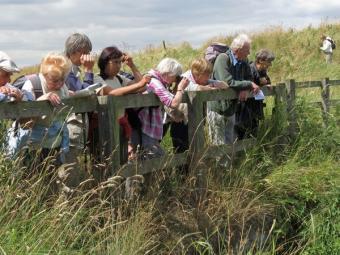 Looking Over The Bridge Our party took equal delight in the special flowers of the area. 138 were recorded in flower. The wetland, field margins, path, reed beds and chalk grassland gave us a varied mix of flowers.The wetland plants included Fool's Watercress, Celery-leaved Buttercup, Water Crowfoot and Water Speedwell. The field margins offered Common Poppy, Wild Mignonette and the pretty Field Bindweed. On the paths were found White Bryony and Prickly Lettuce. On the chalk grassland we found Marjoram, Lemon Balm, Ploughman's Spikenard, Eyebright and Fairy Flax, while in the reed beds were Common Reed, Sea Aster and Bindweed. Many of the flowers were in seed and shrubs and trees laden with fruit. The bird count numbered 20 . Again a variety of birds were seen but in small numbers. Common Terns, Tufted ducks,
Looking Over The Bridge Our party took equal delight in the special flowers of the area. 138 were recorded in flower. The wetland, field margins, path, reed beds and chalk grassland gave us a varied mix of flowers.The wetland plants included Fool's Watercress, Celery-leaved Buttercup, Water Crowfoot and Water Speedwell. The field margins offered Common Poppy, Wild Mignonette and the pretty Field Bindweed. On the paths were found White Bryony and Prickly Lettuce. On the chalk grassland we found Marjoram, Lemon Balm, Ploughman's Spikenard, Eyebright and Fairy Flax, while in the reed beds were Common Reed, Sea Aster and Bindweed. Many of the flowers were in seed and shrubs and trees laden with fruit. The bird count numbered 20 . Again a variety of birds were seen but in small numbers. Common Terns, Tufted ducks, 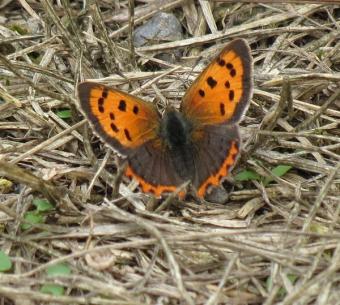 Small CopperGreat Crested Grebes and Greylag Geese were seen on the lakes; Goldfinch and Swallows on the field margins; Reed Bunting and Reed Warbler in the reeds; Lapwing, Curlew and Shelduck on the shoreline. However the highlight was a sighting of a Marsh Harrier. It was observed gliding slowly across a lake before descending into the tree canopy by Margaret on returning to Far Ings. The weather was ideal, warm but cool in places, sunny with a gentle breeze. It remained so throughout the day and for our journey home. A good day out for the 15 of us who enjoyed today's outing. A magnificent job was performed by Stuart in steering the old minibus, rattle and all and returning us to the Unitarian Church car park safely. Thanks to all those who contributed to our day out.
Small CopperGreat Crested Grebes and Greylag Geese were seen on the lakes; Goldfinch and Swallows on the field margins; Reed Bunting and Reed Warbler in the reeds; Lapwing, Curlew and Shelduck on the shoreline. However the highlight was a sighting of a Marsh Harrier. It was observed gliding slowly across a lake before descending into the tree canopy by Margaret on returning to Far Ings. The weather was ideal, warm but cool in places, sunny with a gentle breeze. It remained so throughout the day and for our journey home. A good day out for the 15 of us who enjoyed today's outing. A magnificent job was performed by Stuart in steering the old minibus, rattle and all and returning us to the Unitarian Church car park safely. Thanks to all those who contributed to our day out.
Margaret